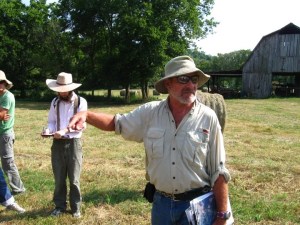Hello my name is Ben Murray, I am going to be one of your blog correspondents for the very exciting Carbon Farming Course Series, that has just started on The Farm in Summertown Tennessee. I was lured here by a series of serendipities and a deep passionate commitment to realize a harmonious integration of the Human family back into harmony with our natural environment. I am a Permaculture designer and carpenter. I am currently based between Nevada City in Ca for half the year and then the other half in Ecuador working with the Red De Guardians De Semillas (seed guardian network).
Holistic Management Course – Day 1:
After a round of introductions, we dove into an overview of Holistic Management, including the 4 Key Insights and the 6 Steps of the Holistic Management Process. As we moved into an understanding of the first Key Insight “Nature Functions in Wholes”, we worked with our own projects to Define exactly what “whole” we are managing. To do this, Kirk introduced us to Stephen Covey[link]’s ‘Circle of Concern’ (all the issues you care about in the world) and ‘Circle of Influence’ (all the areas we can currently influence directly) — this allows us to see what we can and cannot do, and focus our personal energies strategically so to achieve our goals. AND, if we are effective within our circle of influence, this circle can expand outward into our circle of concern.
Kirk also shared some incredible series of slides showing landscape regeneration as the consequence of adopting Holistic Management practices. In these slides you see the impresive impact on the water cycling that ultimately has allowed (in a relatively short amount of time!) to bring this erosion gully into a perennial stream – now full of trout!
Holisitic Management first defines a “whole” to be managed (people, resources and money), and creates what is known as an holistic goal that mirrors these three aspect of the whole. Before implementing projects, any effects on these three aspects must be considered, and the project must simultaneously meet economic standards concerning the viability of the operations.
At present, agriculture and many other businesses are struggling to maintain viability. Decreased income often leads to a focus on increased production and harder work. But, if the fundamental decision making process that led to the present situation is not changed, no real progress is likely to be made. Presently, many people involved in agriculture do not realize they are working against “nature’s rules” and that their efforts are likely to be drastically less successful until they learn to work with this process. In the end, nature always wins and our production systems inevitably must change to be sustainable.
Too often, conventional agriculture focuses almost solely on achieving production goals and solving specific problems, which can create unforeseen and unintended consequences that eventually detract from land health, personal and family time and, ultimately, profitability.
Holistic management is effective because the resource base ultimately supports the financial goals and those of the people involved who depend on the business for their livelihood.
The course is teaching us to define their unique whole, define our unique holistic goal, and to make decisions that are economically, environmentally and socially sound towards our goals. It is a process that works and has a proven track record of more than 20 years.

This course is walk us through the principles that help bring the abundance and diversity of natural systems to large-scale permaculture systems. Managing land holistically integrates land planning, financial planning, grazing planning and biological monitoring to find ways of being efficient and creative with your resources to achieve the environmental and financial results that make for a sustainable, long-term business.
Holistic Management Course – Day 2:
We very simply looked at the utter important of having one’s goals clearly defined to obtain the desired objectives. We explored some of key questions to help unfold and articulate the most important aspects that we want to manifest.
Specifically, we learned that the Holistic Goal includes

Quality of Life (Values – Why?)
Forms of Production (What?)
Future Resource Base (How?)

In the afternoon, we headed out to a local site to do some practical site analysis & assessment. We went out and did some practical exercises using the Kirk Gadzia’s excellent publication “Bulls eye! Targeting Your Range land Health Objectives.” This document gave us simple, clear, measurable benchmarks for monitoring the health and potential regeneration of a piece of grazing land.

Kirk told us a little story about the creation of the tool – he asked,Have you ever shot a gun or a bow at a target? What are you trying to do? What are you trying to hit when you shoot at a target
most people have an understanding and a relationship to the target. IT’s a deeply archetypal form in our head.
Hit the bulls eye, of course. So Kirk & Todd Graham designed this tool to help us quickly evaluate the health of a grazing landscape. We looked at Plant Species Diversity, Amount of Erosion, Plant Pedastaling, Diversity of Living Organisms, and 10 other criteria. The publication also gives some guidelines for articulating your goals and directions to go for grazing land management tools and actions. You can download the whole publication for free at Kirk’s website here.















